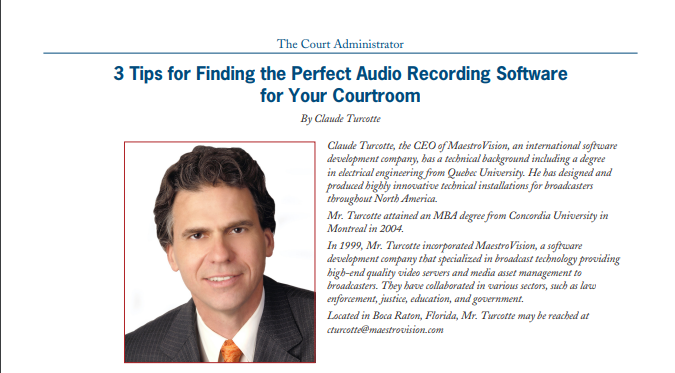Claude Turcotte, CEO of MaestroVision was recently featured in the International Association for Court Administration’s Official Publication.
See the article below…
3 Tips for Finding the Perfect Audio Recording Software for Your Courtroom
As a Court Administrator, investing in a court recording software that is easy to use, flexible and makes sharing recordings a simple task is critical to meet the guidelines of your role. My 25+ years of audio/video experience has allowed me to formulate this list of 3 factors to consider as you begin your search for the right software for your courtroom. I hope it’s helpful.
1. Base your search on your answers to the following questions:
-
- How many channels of audio do I need to record simultaneously?
- Do I have a docket I need to upload into the system for metadata or bookmarks purposes?
- Do I need to import data from a case management system?
- How will I be sharing or storing recordings: email, DVD, USB, a link?
- Will I or any other users using a foot pedal to replay recordings?
- What metadata fields are pertinent in each recording?
- Ex: Case name, case number, case ID, Judge, time and date of record, court department, location, name of witness, defendant or any other pertinent information.
2. Consider the need for a media library. A media library stores your recordings in an on-premise or cloud-based application that can be accessed by as many or as little users with login credentials as you’d like. With a media library, users can….
-
- Search recordings by metadata
- Add bookmarks after recordings are finished
- Export and trim recordings
- Set up a user permissions hierarchy
- Isolate channels during playback and more
3. If you’ve decided to invest in a media library, the next step is to decide whether you’d like the storage to be on-premise or cloud-based. Before you make the decision, please read on to learn how they work…
An on-premise video library is an application installed at your location. It uses your computers and your hardware storage. Sometimes, the Information Technology specialist (IT) will install a “Virtual Server” on the existing hardware including an SQL application and the video library application. Subsequently, if the IT specialist configures the library correctly, it becomes a corporate cloud application. Cost-wise, normally on-premise applications are purchased and owned, with ongoing annual fees for updates and maintenance. The pros mainly concern security. Many legal entities are very reluctant to have sensitive information outside their physical control.
Cloud applications are very secure, but there are ongoing fees to consider. In the long term, an in-house facility is less expensive. The short term is more expensive as all hardware and software need to be procured as well as ongoing maintenance costs. Finally, there is a question of Internet access. If you always access the library from your internal Ethernet network, all is good. But if you require users to access the database from outside the internal network, the Internet connection will need updating to a much higher upload speed, to allow users access to the video library at the same time. The cloud has the same features as an on-premises installation except the application is based outside your locations in a “Data Center”. The Data Center is not your provider, it is a service purchased by your provider. Your provider rents rack space in the Data Center where the hardware is installed. The provider also rents a huge upload Internet connection allowing him to service many customers at the same time. The benefits of the Data Center are the enormous pipeline of data it can provide, and the very high levels of security to access the environment. The cloud service is generally offered on a monthly payment program. Naturally, the provider will require a signed contract and will charge for configuration and installation.
Short term it is less expensive, as there is no need to purchase equipment and staff-time to implement the solution. The connection to the library will be much faster and more accessible worldwide by many users simultaneously. The solution will cost more on a long-time basis. Even though the solution is very safe, there is a security issue perception, due to the fact that people other than your own staff are in charge of the hardware.
Once you’ve got an idea of what you want in a media library, storage and the specifications you’ll need to be fulfilled, you’re ready to begin booking appointments with vendors. Remember to be as transparent about what you want in these appointments, so you don’t waste any time on software that doesn’t fit your needs. Good luck!


